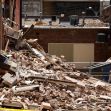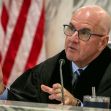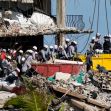The heart-breaking wall with pasted flyers of over a hundred faces shows signs of wear and tear as day four breaks over the tragedy in Surfside, Florida.
Not one face of a loved one has been removed from this memorial since no one has been pulled from the concrete carnage since the building collapsed on Thursday, at about 1:30 AM.
Today, there are sixteen fatalities and more than 147 people unaccounted for as a result of the seaside condo crumbling in a shocking and devastating collapse.
Resident Manuel Dresser, who lives in Champlain Towers South, filed a class-action lawsuit in Miami-Dade County after about half of the building he lives in collapsed on Thursday.
Drezner said the lawsuit is to "compensate the victims of this unfathomable loss."
In court documents, the plaintiff alleges Champlain Towers South Condominium Association Inc. "failed to adequately secure the building, placing the lives and property of its occupants and visitors ... at risk resulting in the collapse of the building. At all relevant times, the defendant was aware, or reasonably should have been aware that the plaintiff's and the class's lives and property were at risk due to the lack of precautions taken at Champlain Towers South."
Local officials have not shared any official, clear-cut ideas about what may have caused this 136-unit, forty-plus-year-old structure to collapse in the middle of the night. For now, there is only speculation.
However, national and international scientists have warned of rising sea levels and their potentially tragic impact upon buildings set upon the ever-changing sands of the seashore, including the sands of Miami beaches, for decades. As a result, many miles of condos and buildings are built upon the barrier island.
There is a litany of potential engineering disasters for beachside buildings. The sea air is corrosive and may damage building materials. The grounds are shifting, so the buildings may experience settling, leading to catastrophic events such as structural failure.
Attorney Kenneth Direktor has worked for the condo association since 1993. In an interview with the Miami Herald, he said the association was working with an engineer to conduct a 40-year recertification process. This process is legally required as part of the Miami-Dade County building code.
"They were well into the review with the engineer about the project," Direktor said.
But as Peter Zalewski, a principal of real estate analysis firm Condo Vultures, noted, "I've been here since 1993, and I've never seen something like this happen. You would think any problems that large would have been detectable. If recertification was being done, expect reports that say what problems currently exist in the building. I have a feeling that something else is going to be discovered that happened that we can't assume right off the bat. Forty-year-old buildings don't just collapse, and there's a whole series of them lining up and down the coast."
As the search and rescue will inevitably transform into a search and recover mission, there are many legal questions to consider.
With all eyes on the unfolding tragedy, prior lawsuits against the safety of the building are being revisited.
Two residents of the Surfside, Fla. condo sued the building authorities due to dangerous conditions over the past few years.
In 2001 a condo owner sued the Surfside, Fla. condo association due to cracking but settled out of court.
In 2015, a condo owner sued the condo association in Miami-Dade County. Court documents said the association was liable for the $15,000 expense since the cracks were "a structural issue."
Numerous families of missing residents of the collapsed condo and current residents are telling news reporters about cracks on ceilings or the walls and other frightening warning signs occurring for years.
A shocking new report by Morabito Consultants in 2018 by engineers stated the pool deck had "major structural damage" and needed major repairs and that there was "abundant cracking and spalling" of concrete beams, columns, and walls in the parking garage.
In response to questions about the collapse of the condo building, Morabito Consultants said their 2018 report "detailed significant cracks and breaks in the concrete, which required repairs to ensure the safety of the residents and the public."
Legal experts expect a slew of lawsuits from both survivors, current residents, and the families of loved ones killed by the tragic event.
Legally, liability issues, compensation for loss, and even national responsibility are on the table for forthcoming lawsuits.
Who is liable for this tragedy?
Engineer reports noting significant damage were shared with the condo association. The township of Surfside and Miami-Dade County may be liable. Board members who received complaints of any structural damage or warnings may be sued. Engineers may also be liable for not making their structural warnings much more significant.
The HOA had insurance for the building, and the residents had homeowner's insurance for the "walls in." Typically, the condo insurance has a value for the building itself, and the condo owners own insurance for anything inside their dwelling.
Will the insurance find an exception to coverage, especially if there were warnings? Historically, insurance companies have fought to avoid paying full price on the loss of dwelling.
Another issue is that with such a significant and tragic loss of people, the insurance coverage, including umbrella coverage, is not expected to be substantial enough for this type of tragic loss.
Another liability issue may be the timing it takes for an engineer to study a buoying within the 40-year period required by Miami-Dade County for inspection. However, the 40-year certification may not be completed for years past the due date since significant work, as in this particular condo as noted in the engineering report, may not be computed quickly.
The laws may need to change to a thirty or twenty-year certification period for corrosive environments such as water and salt facing the beachfront properties.
Like the shifting sands of the beach barrier show, building ocean-side homes can be a dangerous and heart-breaking undertaking.






